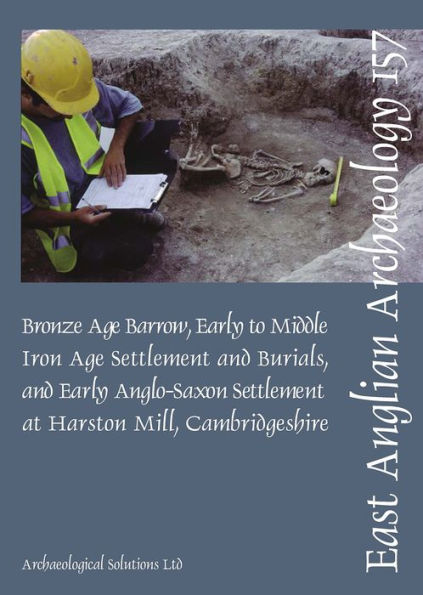Early to Middle Iron Age Settlement and Early Anglo-Saxon Settlement at Harston Mill, Cambridgeshire
A Bronze Age barrow, one of several in the Rhee valley, was encircled by two concentric rings of posts in the early to middle Iron Age, and a single crouched inhumation was buried nearby. A small group of roundhouses and granaries was built on the clays c.100m from the river, and nearly 200 possible grain storage pits were dug on chalk deposits next to the river. Some of the pits contained human burials and animal bone groups of the pit burial tradition common in central southern and southeastern England Significant assemblages of Chinnor-Wandlebury pottery and animal bone, including examples of rarely-found wild species, were also found. The site was unoccupied in the late Iron Age and Roman periods but still farmed, as evidenced by animal pens, field ditches and sparse domestic debris probably spread by manuring. During the later 6th century AD, a small open farming settlement of six sunken-featured buildings was established, akin to many similar settlements investigated in South Cambridgeshire. A substantial ditch enclosed the settlement in the 8th or 9th century, and occupation had shifted to Harston village by the 10th century.
"1123848741"
Early to Middle Iron Age Settlement and Early Anglo-Saxon Settlement at Harston Mill, Cambridgeshire
A Bronze Age barrow, one of several in the Rhee valley, was encircled by two concentric rings of posts in the early to middle Iron Age, and a single crouched inhumation was buried nearby. A small group of roundhouses and granaries was built on the clays c.100m from the river, and nearly 200 possible grain storage pits were dug on chalk deposits next to the river. Some of the pits contained human burials and animal bone groups of the pit burial tradition common in central southern and southeastern England Significant assemblages of Chinnor-Wandlebury pottery and animal bone, including examples of rarely-found wild species, were also found. The site was unoccupied in the late Iron Age and Roman periods but still farmed, as evidenced by animal pens, field ditches and sparse domestic debris probably spread by manuring. During the later 6th century AD, a small open farming settlement of six sunken-featured buildings was established, akin to many similar settlements investigated in South Cambridgeshire. A substantial ditch enclosed the settlement in the 8th or 9th century, and occupation had shifted to Harston village by the 10th century.
50.0
In Stock
5
1

Early to Middle Iron Age Settlement and Early Anglo-Saxon Settlement at Harston Mill, Cambridgeshire
250
Early to Middle Iron Age Settlement and Early Anglo-Saxon Settlement at Harston Mill, Cambridgeshire
250Paperback
$50.00
50.0
In Stock

Product Details
| ISBN-13: | 9780993247705 |
|---|---|
| Publisher: | East Anglian Archaeology |
| Publication date: | 02/29/2016 |
| Series: | East Anglian Archaeology Monograph , #157 |
| Pages: | 250 |
| Product dimensions: | 6.00(w) x 1.25(h) x 9.00(d) |
From the B&N Reads Blog
